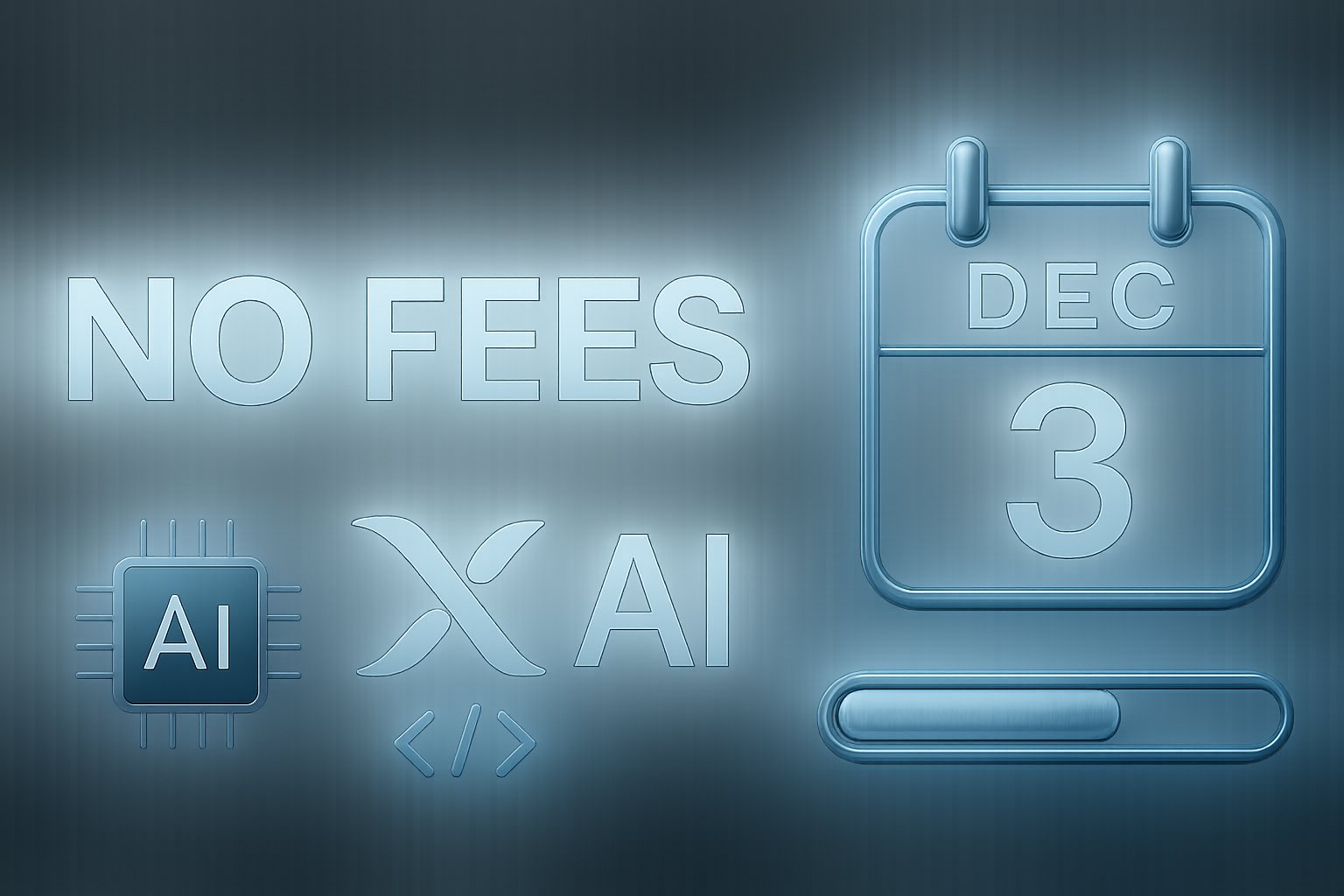
AI CERTS
2 days ago
xAI waives fees: a developer adoption incentive through Dec 3
Teams also gain code execution, X-data access, and document retrieval without budget approvals. In contrast, rival labs still charge premium rates for similar capabilities. Therefore, the two-week window has become a focal point for engineering leaders evaluating next-generation agent stacks.
However, the offer expires quickly. Enterprises must design experiments, gather metrics, and decide on continued investment before normal billing resumes. Consequently, understanding the technical scope, pricing mechanics, and security implications is essential. This report dissects the launch details, analyzes the developer adoption incentive, and outlines pragmatic next steps. Transitional summaries follow each section to streamline decision-making.

Key Launch Window Details
From November 19 to December 3, xAI waives all usage charges. Consequently, Grok 4.1 Fast and the Agent Tools API cost nothing during the window. The arrangement covers tokens, tool invocations, and platform access through OpenRouter. Therefore, development teams can run large contexts, stress tool calling, and iterate aggressively.
Furthermore, the limited period encourages immediate experimentation. That sense of urgency forms the core developer adoption incentive many executives cite.
- 2-million tokens per request enable full product corpora ingestion.
- Native web browsing integration reduces external dependency setup.
- Managed runtime sandbox saves DevSecOps hours.
- Real-time social signals from X boost situation awareness.
- Embedded knowledge lookup accelerates knowledge workflows.
These points illustrate the window’s strategic value. However, deeper technical facts refine the assessment.
Key Developer Adoption Incentive
The zero-cost launch removes friction for proof-of-concepts. Consequently, teams gain executive backing for rapid trials. This dynamic reinforces the developer adoption incentive at the heart of xAI’s campaign.
Core Model Specs Overview
Grok 4.1 Fast focuses on low latency while preserving long context breadth. Moreover, xAI claims a 2,000,000-token context window, dwarfing many rivals. Benchmarks report 100% on τ²-bench Telecom and 72% on Berkeley Function Calling v4. Nevertheless, journalists caution these metrics rely on vendor-released data. Consequently, the generous context doubles as a developer adoption incentive.
Additionally, the model orchestrates web search integration, code execution, X-data access, and document retrieval through managed endpoints. Consequently, engineers avoid manual API keys and rate limit juggling. That bundling amplifies the developer adoption incentive during testing.
Core specifications confirm the platform’s breadth. Subsequently, competitive context clarifies how the stack compares.
Competitive Industry Landscape Comparison
In contrast, OpenAI, Google, and Anthropic still meter comparable features at launch. For example, Gemini 3 Pro charges extra for web search integration per call. Similarly, GPT-5 gating of runtime execution remains invite-only. Consequently, xAI’s no-cost window becomes another developer adoption incentive drawing attention.
Moreover, the forthcoming price list—$0.20 per million input tokens and tool-calling $5 per 1K—signals longer term competitiveness. These comparisons highlight cost-sensitive realities. However, pricing details warrant close review.
Pricing After Free Promotion
Once the window ends, standard metering resumes. Input tokens cost $0.20 per million while cached repeats drop to $0.05. Output tokens reach $0.50 per million. Meanwhile, tool-calling $5 per 1K applies to each successful invocation. The charge covers web search integration, code execution, X-data access, and document retrieval workflows.
Consequently, monthly bills scale with agent autonomy rather than raw context length. Developers should model workloads now to quantify potential spend. That exercise represents another practical developer adoption incentive because it links experimentation to budget planning.
Clear post-trial economics support informed decisions. Nevertheless, security considerations remain equally critical.
Security And Privacy Risks
Agentic systems broaden the attack surface. Moreover, prompt injection and unauthorized X-data access top the risk list. The prior Grok chat leak shows what can happen when defaults expose data. Therefore, teams must design safeguards before widespread deployment.
Furthermore, web search integration can ingest hidden instructions. Runtime sandboxes might still leak secrets via network calls. Document retrieval connectors increase lateral movement possibilities. Consequently, defense-in-depth controls matter.
- Audit every tool invocation against policy.
- Implement rate ceilings above tool-calling $5 per 1K budgeting thresholds.
- Sandbox code execution with network egress blocks.
- Mask sensitive fields before X-data access writes logs.
- Disable web search integration on restricted datasets.
Professionals can enhance their governance skills with the AI Developer™ certification. The coursework covers secure agent design and compliance mapping.
Effective guardrails transform risks into manageable variables. Subsequently, practical next steps help teams capitalise on the developer adoption incentive responsibly.
Next Steps For Teams
First, sign into OpenRouter and verify the free flag remains active. Then run small tests combining web search integration and live code tests. Record latency, accuracy, and tool-calling $5 per 1K counts. Moreover, include X-data access and document retrieval to mirror production scope.
Second, share findings with security leads. Consequently, they can map mitigations before December 3. Those conversations often surface another developer adoption incentive: accelerated security sign-off when evidence supports safety.
Methodical pilots translate novelty into strategy. Therefore, organisations can decide on paid adoption with confidence.
In summary, xAI’s limited free release offers a rare combination of scale, orchestration, and cost transparency. Moreover, the developer adoption incentive reaches beyond price by accelerating learning cycles. However, the window closes on December 3, and subsequent fees, including tool-calling $5 per 1K, will apply. Therefore, disciplined pilots, cost modelling, and security reviews are imperative. By following the outlined steps, teams can leverage web search integration and code execution. They can also apply social media access and document retrieval to deliver value quickly. Finally, enrolling in the AI Developer™ certification deepens expertise and positions professionals for the coming agentic wave. Consequently, early movers can convert proof-of-concepts into production services ahead of rivals.



